We’re
now
into
Spring
2021
and
no
progress
has
been
made
at
the
mill
site
so
far
this
year
other
than
landscaping
and
maintenance.
Behind
the
scenes
however
Adam
has
been
pushing
the
project
forward
despite
prolonged
delays
and
material
shortages
due
to
the
Covid
lockdown.
He
has
now
made
and
fitted
the
timber
spokes
and
blades
to
the
cast
iron
hub
of
the
fantail.
The
fan
will
be
mounted
on
an
axle
fitted
between
the
two
‘spears’
visible
in
the
second
shot
which
have
just
been
fitted
and
are
leaning
against
the
‘gallows’.
Alan’s
figure
standing
in front of it give an idea of the large size of these components.
Filey’s Windmill
Recreating an iconic building

Powered by Xara Web Designer
We
are
currently
basking
in
a
warm
glow
of
satisfaction
at
seeing
the
rebuilding
of
the
tower
finally
completed.
This
has
been
tempered
somewhat
by
concern
at
the
way
the
recent
gales
are
affecting
the
waterproof
sheet
providing
the
weatherproofing.
We
had
hoped
the
two
cargo
straps
we
used
would
prevent
unwanted
movement
but
the
bottom
strap
was
being
lifted
by
the
force
of
the
wind
thus
allowing
the
sheet
to
be
pulled
upwards.
We
were
sure
that
the
top
strap
being
tight
under
the
corbeling
would
prevent
it
blowing
off
but
we
needed
to
secure
the
skirt
otherwise
it
would
tear
itself
to
shreds.
The
height
of
the
mill
meant
we
couldn’t
do
the
work
off
ladders
and
the
cost
of
scaffolding
it
was
£5000
so
it
was
decided
to
use
a
cherry
picker.
Ring
bolts
were
securely
fixed
into
the
brickwork
and
lines
passing
through
eyelets
in
the
sheet
tied
off
to
them.
Finally
two
lines
were
passed
over
the
top
and
secured
in
the
same
way.
We
have
our
fingers
crossed
that
this
will
prove
an
adequate
answer
until
next
summer
when
we
hope
to
see
the
cap
fitted.
Meanwhile
we
are
planning
a
more
substantial
solution
to
be
fitted
after Christmas.
We
were
very
pleased
to
receive
news
from
our
millwright
Neil
Medcalf
that
he
has
obtained
a
second-hand
curb
to
mount
the
cap
on.
This
means
we
should
save
several
thousand
pounds
over
the
cost
of
having
a
new
one
cast
specially,
as
was
originally
budgeted
for.
This
will
release
more
cash
towards
the
cost
of
the
sails
which
will think will be the icing on the cake!
Good News from Lincolnshire


November 2017
It
seems
as
though
there
has
been
continuously
stormy
weather
all
through
December
and
January
and
the
persistent
gales
proved
far
too
much
for
the
original
waterproof
sheet
covering
the
mill
despite
the
recent
repairs.
The
resulting
leaks
allowed
considerable
volumes
of
water
entered
the
building
soaking
the
internal
timber
work.
Emergency
repairs
had
to
be
made
from
inside
the
tower
and,
once
the
leaks
were
stopped,
heaters
and
dehumidifiers
were
pressed
into
urgent
service.
We
redoubled
our
efforts
to
complete
the
design
of
a
more
substantial
tailor-
made
solution
and
contacted
several
local
suppliers;
the
contract
finally
going
to
Mark
Britton
at
I
&
M
Tarpaulins
of
Full
Sutton.
We’re
now
waiting
for
it
to
be
delivered
and
suitable
weather
conditions to put it in place.
More Weather Woes

Cap That!

On
the
first
weekend
in
February
everything
finally
came
together.
We
had
the
cherry
picker,
the
newly
fabricated
reinforced
PVC
cap
and
the
weather
window
we
needed.
It
took
a
lot
of
hard
work
to
unfasten
and
release
the
remains
of
original
tarpaulin
and
man-handle
the
replacement
up
the
three
staircases
inside
the
tower.
We
held
our
breath
until
we
were
sure
it
fitted
over
the
brickwork
satisfactorily
and
then
finally
tied
off
the
securing
lines
and
ratcheted
up
the
cargo
straps,
unfortunately
due
to
time
pressure
we
didn’t
get
it
quite
square
but
we
can
straighten
it
later
when
the
curb
is
fitted.
We
believe
this
time
we
really
have
got
something
which will survive anything the weather can throw at it!

The
spring
and
summer
months
have
flown
by
and
despite
lots
of
action
behind
the
scenes
there
have
been
no
major
changes
in
the
exterior
of
the
mill.
The
grounds
it
stands
in
however
have
had
their
appearance
much
improved.
The
hedges
have
been
trimmed
back
and
the
two
acres
of
grass
are
being
maintained
under
contract
by
Countrywide
Services.
A
programme
of
regular
strimming
and
mowing
has
begun
the
process
of
suppressing
perennial
weeds
and
improving the texture of the turf.
During
the
winter
months
we
had
problems
with
vehicle
access
to
the
mill
so
it
was
decided
to
go
ahead
with
the
new
entrance,
access
road
and
parking
area
as
agreed
with
the
planners
which
will
provide
easy
all-year-round
access
to
the
site.
After
considering
several
quotes
we
gave
the
contract
to
BDS
of
Driffield
and
we
were
pleased
with
the
results
when
their
team
completed
the
job
of
excavating,
strengthening
and
then
surfacing
the
redesigned approach.


Quite
late
in
the
autumn
we
were
fortunate
to
secure
the
services
of
John
Edmond,
an
expert
local
builder
with
experience
of
working
on
old
buildings,
who
undertook
the
job
of
finishing
off
renovation
work
on
several
areas
of
the
original
brickwork
which
had
deteriorated
during
its
long
period
of
dilapidation.
His
first
tasks
were
to
reconstitute
the
window
apertures,
replacing
missing
and
damaged
bricks,
and
to
rebuild
the
sills.
He
also
designed
and
fitted
stainless
steel
lintels
to
reinforce
the
arches
over
the
original
windows.
With
the
brickwork
complete
Andrew
Stronach
from
Ryedale
Joinery,
who
we
had
commissioned
to
design
the
windows,
came
and
fitted
the
first
four
on
the
top
two
floors.
They
are
centre-hinged
to
match
the
originals
and
at
Andrew’s
suggestion
they
were
made
from
Accoya
which
is
a
special
long
life
and
low
maintenance
timber. We are delighted with their classic period appearance.

Despite
our
earlier
optimism
the
second-hand
curb
found
in
Lincolnshire
did
not
turn
out
to
be
suitable
for
our
mill
and
we
will
therefore
be
forced
into
the
expense
of
having
a
new
one
cast.
We
have
asked
Adam
Marriott
an
expert
millwright
from
Teme
Valley
Engineers
to
visit
the
mill
and
make
a
template
of
the
top
brickwork
locating
exactly
the
positions
of
the
holes
for
the
securing
bolts.
He
will
then
have
a
wooden
pattern
made
and
commission
a
foundry
to
cast
the
eight
segments
needed
in
a
suitable
grade
of
iron
together
with
its
associated
pinion
to
mesh
with
the
curb
teeth.
These
will
be
secured
through
a
new
oak
frame
he
will
make
in
his
workshop.
He
hopes
this
can
then
be
re-assembled
in
the
mill
field
and
craned
into
position
in
the
new
year.
When
this
crucial
work
is
done
we
can
start
to
make
plans
for
the
timber
ogee
cap
and
fantail
to
be
built
and fitted.
Gardening on a Grand Scale
Millwrighting Progress
Windows on the World
The Road Ahead
We
have
come
to
realise
that
without
a
separate
secure
store
for
the
safety
and
maintenance
equipment
required
for
the
operation
of
the
completed
windmill
will
be
impossible.
It
will
also
be
needed
when
work
begins
on
assembling
the
new
curb,
cap
and
fantail
which
will
be
carried
out
on
location
prior
to
being
raised
into
place.
Rather
than
apply
for
an
additional
building
we
have
asked
the
Planning
Department
for
permission
to
change
the
official
use
and
rebuild
the
existing
animal
shelter
and
store
which
has
stood
in
the
field
for
many
years.
This
will
include
moving
its
location
over
the
hill
top
thereby
making
it
virtually
invisible
from
Muston
Road
and
so
improving the visual amenity of the area.

Planning Application



One
of
our
major
concerns
from
the
outset
has
been
how
to
obtain,
at
the
least
possible
expense,
the
heavy
metal
castings
we
needed
to
complete
the
project.
The
largest
and
most
important
of
these
is
the
cast
iron
axle
the
sails
are
fixed
to
and which is known in the milling world as the ‘windshaft’.
For
those
interested
there
are
two
types
of
windshaft
which
differ
mainly
in
the
way
the
sails
are
mounted:
the
Lincolnshire
type,
where
the
‘whips’
are
clamped
to
the
‘iron
cross’,
and
the
pole-end
type,
more
common
in
the
south
of
England
where
they
fit
into
two
sockets.
As
we
want
to
make
the
restoration
as
faithful as possible to the original it had to be the Lincolnshire type.
We
looked
for
years
for
a
second-hand
one
without
any
luck
and
finally,
as
we
mentioned
in
an
earlier
entry,
we
had
to
ask
Adam,
our
millwright,
to
make
a
new
one.
He
commissioned
a
pattern
maker
to
produce
a
precise
copy
of
half
a
shaft
of
the
correct
size
and
type
mounted
on
a
back
board
and
this
was
delivered
to
H.
Downs
&
Sons,
Peacock
Works,
Huddersfield,
W.
Yorks
the
foundrymen.
There
they
created
a
sand
mould
to
produce
the
rough
casting.
The
picture
to
the
right
shows
the
pattern
being
used
at
the
foundry.
In
the
centre,
painted
red,
is
the
pattern
and
split
in
two
on
either
side
of
it
is
the
white
painted
mould.
Metal
is
expected
to
be
poured
shortly
and
we
will
show
the
actual
shaft
before
it
is
sent
off
for fettling and machining.


2020 - Breaking the Mould
Click on the image to enlarge it

The
pattern
makers
proved
their
worth
as
you
can
see
I
n
the
photograph
on
the
left.
There,
awaiting
collection
and
weighing
three
tons,
are
a
brand
new
12ft
span
iron
cross
and
19ft
long
windshaft.
They
are
beautiful
examples
of
the
foundry-man’s
art
and
Adam
will
now
be
sending
them
to
be
machined.
He
was
restricted
in
his
choice
of
engineering
workshop
as
these
items
require
a
much
larger
lathe
than
usual
to
accommodate
their
size
and
weight.
Once
the
bearing
surfaces
are
turned
they
will
be
ready
to
be
painted
and
mounted
into
the
cap
he
is
currently
building.
Obtaining
these
unique
and
vital
components
represents
a
major
breakthrough
in
our
long
battle
to
restore
Muston
Mill
and
we
must
give
full
credit
to
Adam
whose
knowledge
and
experience
in
arranging
and
supervising
this
important
stage
has
been
crucial.
He
is
playing
an
indispensable
role
in
helping
us
rescue
this
historic
building
from
total
collapse
and
its
subsequent
disappearance
from
the Yorkshire landscape.
Click on the image to enlarge it
Cast to Perfection

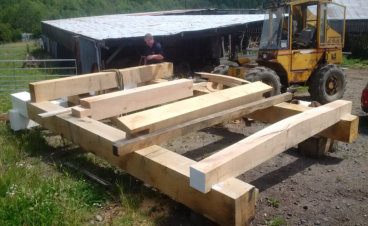

Heart of Oak
While
we
waited
for
the
castings
to
be
finished
Adam
checked
his
suppliers
for
the
timber
he
needed
to
begin
building
the
cap.
The
two
main
beams
or
‘sheers’,
running
fore
and
aft,
form
the
base
of
the
cap
and
are
cut
from
green
oak
for
strength
and
durability.
Let
into
them
at
the
front
is
the
‘weather
beam’
which
supports
the
front
of
the
windshaft.
Their
size
and
their
weight
makes
shaping
and
joining
them
a
major
operation
as
you
can
see
from
the
left
hand
photograph.
A
high
degree
of
accuracy
is
essential
to
ensure
the
safe
operation
of
the
mill.
The
second
photograph
shows
the
timbers
which
will
be
used
to
complete the cap frame laid out ready for final assembly.
Click on the image to enlarge it
Click on the image to enlarge it
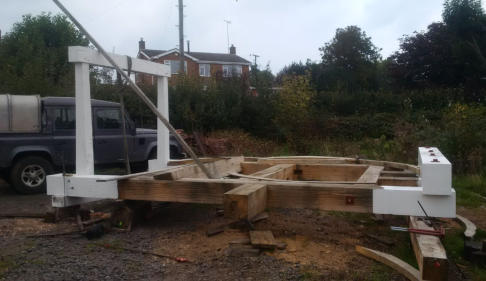
Work
continues
on
the
cap
as
can
be
seen
below.
The
frame
has
been
assembled
and
bolted
together
and
the
gallows
which
will
support
the
fantail
are
in
position.
Adam
has
got
special
white
paint
on
the
woodwork
which
will
be
subject
to
most
of
the
weather.
Meanwhile
patterns
and
castings
are
being
made
for
various
other
components
the
biggest
of
them
being
the
fantail
hub
on
which
the
fan
blades
will
be
mounted.
After
the
years
of
frustration
and
delay
we
are
excited
to
see
steady
progress
being
made
at
last.
Some
of
the
delay
and
most
of
the
expense
is
caused
by
the
need
to
have
all
the
metalwork
items
created
as
one-offs
as
there
are
no
sources
to
obtain
them off-the-shelf.
Click on the image to enlarge it
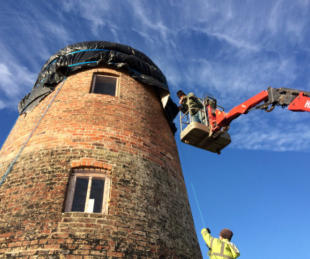

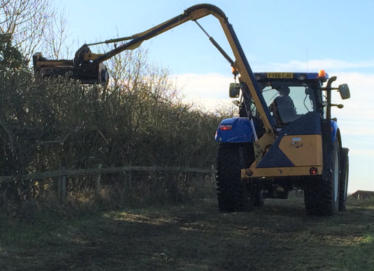




Click on the image to enlarge it
Click on the image to enlarge it
Click on the image to enlarge it
Click on the image to enlarge it
To be continued…

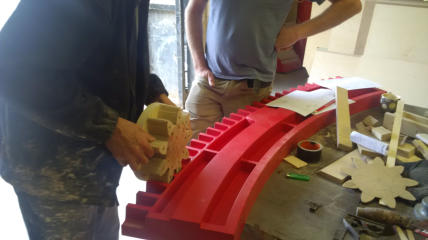
Exciting
news
from
our
millwright
Adam
Marriott.
The
eight
cast
iron
curb
sections
and
the
cap
drive
pinion
should
be
finished
very
soon
and
after
delivery
to
his
workshop
for
fettling
they
will
be
assembled
with
the
substantial
oak
frame
and
bolted
down
onto
the
mill
tower.
The
photographs
below
show
the
restoration
grade
oak
frame
sections
and
Adam
in
the
pattern
makers
workshop
viewing
the
wooden
patterns
for
the
curb
section
(painted
red)
and
the
matching
pinion
(painted
yellow).
All
being
well
the
curb
installation
will
happen
in
July.

Conforming to Pattern
Click on an image to enlarge it

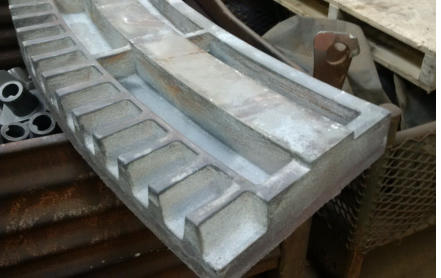
After
some
unlooked
for
delays
we
are
pleased
to
report
we
now
have
eight
perfect
castings
fresh
from
their
mould
and
Adam
is
planning
to
bring
them
up
to
Filey
and
assemble
them
on
top
of
the
mill
tower
in
the
next
few
weeks.
This
will
mean
hiring
a
cherry
picker
to
enable
us
to
lift
off
the
cover.
The
castings
will
be
secured
to
the
oak
frame
and
then
the
whole
assembly
craned
into
position
and
bolted
down
to
the
oak
pads
embedded
in
the
brickwork
before
replacing
the
cover
again.
Unfortunately
anyone
viewing
the
mill
afterwards
will
not
be
able
to
see
the
progress
we
are
making
but
our
plans
for
the
restoration
are
moving
slowly
but
surely
forward.
The
photographs
above
show
the
new
castings
at
Purbright
&
Co
who
carried
out
the
work
prior
to
being
collected by Adam for fettling.
The Die is Cast

Click on an image to enlarge it


Meanwhile… its gone pitch black at the mill
After
several
weeks
of
dry
sunny
weather
in
the
summer
we
were
determined
to
get
a
coat
of
waterproofing
tar
onto
the
mill
before
the
winter
arrived.
The
problem
was
that
there
didn’t
appear
to
be
any
producers
of
this
invaluable
product
left
in
the
UK;
however
we
eventually
managed
to
import
two
drums
from
a
supplier
in
Spain
and
John
Edmond
and
his
team
soon
had
a
couple
of
coats
worked
well
into the brickwork to provide a vital seal against damp. We think it looks pretty good as well!


The Crowning Glory of 2019
It
was
getting
a
bit
late
in
the
year
when
Adam
was
finally
able
to
complete
the
job
of
assembling
the
curb
in
the
mill
field
but
the
weather
held and conditions were perfect for craning the weighty oak frame and cast iron sections up on to the tower.
After
steering
it
into
position
it
didn’t
take
him
long
to
pass
the
eight
holding
down
bolts
through
the
brickwork
and
tighten
the
huge
square
nuts
in
the
top
room
onto
their
oak
pads.
Finally
we
had
just
enough
light
to
replace
the
waterproof
cover
and
tie
it
down
securely
again
before darkness fell. The mill is ready again to withstand the predictable winter gales and rain.


Over
the
next
few
months
Adam
is
arranging
for
a
windshaft
to
be
cast
and
is
building
a
brake
wheel
for
us
before
starting
on
the
cap
and
fantail.
Our
local
friends
are
eager
to
see
the
project
finished
but
few
people
realise
how
much
hard
work
and
expertise
is
needed
to
produce the hand crafted components required to make a proper job of restoring this historic structure.
We’re celebrating the end of another successful year of slow but steady progress and looking forward to more of the same in 2020.
Click on an image to enlarge it
Click on an image to enlarge it

These
two
photographs
illustrate
just
what
a
massive
job
it
is
to
make
a
cap
and
fantail
for
a
traditional
windmill.
Adam
standing
proudly
in
front
of
the
fan
in
the
above
photograph
gives
an
idea
of
the
size
of
the
components
involved.
When
mounted
high
on
the
spears
and
turning
on
its
axle
it
will
dominate
the
landscape
even
before
we
consider
the
sails.
The
complete
cap
when
craned
into
position
will
finally
sit
on
the
30
feet
high
brick
mill
tower.
It
will
make
a
very
imposing
sight indeed standing beside the road on the way into Filey.

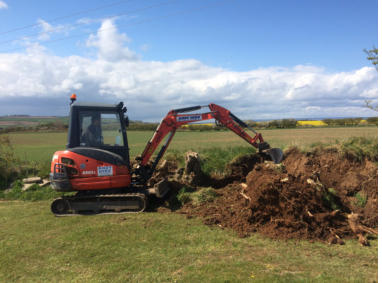
We Refuse to be Stumped
While
we
are
waiting
for
Adam
to
finish
building
the
cap
we
decided
that
it
was
a
good
time
to
sort
out
the
mill
field’s
western
boundary.
We
had
no
problems
removing
the
stock-
proof
fence
which
was
no
longer
required
and
in
the
process
grubbing
up
the
remains
of
several
previous
fences
consisting
of
lengths
of
rusty
barbed
wire
and
broken
posts.
We
then
faced
the
massive
task
of
getting
rid
of
a
dozen
large
ash
tree
stumps
which
had
been
growing
in
the
hedgerow
for
many
decades
before
we
could
start
preparing
the ground for some new hawthorn hedging. After consulting
on
the
best
way
to
tackle
the
job
we
hired
a
3-ton
digger
and
Paul
who
operated
it
for
us
made
short
work
of
digging
around
the
roots
and
lifting
them
out
of
the
resulting
holes.
The
problem
then
was
how
to
remove
the
exceedingly
heavy
stumps
themselves
from
the
site.
Fortunately
for
us
Chris
and
John
Gibson
very
kindly
came
to
our
assistance
and
provided
a
large
capacity
loader
together
with
a
tractor
and
tipping
trailer
which
did
the
job
brilliantly.
All
that
remains
to
be
done
now
is
to
landscape
the
bank
prior
to
planting
around 200 young hawthorn whips in the autumn.


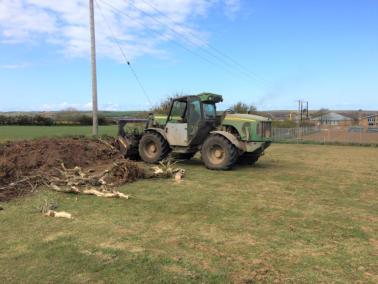
Click on any image to enlarge it




A Tale of Two Cherry Pickers
With
the
arrival
of
August
we
decided
now
was
the
best
time
to
get
another
two
or
three
coats
of
tar
onto
the
mill
to
continue
the
work
of
waterproofing
the
walls.
In
order
to
complete
the
job
as
quickly
as
possible
we
hired
two
identical
cherry
pickers
from
Andy
Hire
to
supplement
the
scaffold
tower
and
ladders
we
had
to
hand
already.
Masking
the
windows
was
the
first
task
as
brushing
on
viscous
tar
is
a
messy
and
uncomfortable
business.
Then
we
managed
to
get
three coats on inside the week as the weather treated us kindly.
Meanwhile news from Adam…
We
had
several
telephone
conversations
with
Adam
during
the
Summer
months
in
which
he
explained
the
difficulty
he
was
having
in
getting
hold
of
the
right
size
and
quality
oak
and
elm
timber
he
needs
to
complete
the
woodworking
of
the
cap.
It
has
been
a
very
frustrating
time
for
everyone
but
we
were
cheered
by
the
photograph
below
he
sent
us
of
the
part-finished
oak
finial
he
is turning to sit on top of the mill when it has been completed.
The
next
picture
he
sent
was
of
the
iron
cross
and
the
windshaft
finally
joined
together
finished
in
red
lead
and
brought
back
to
his
yard.
The
half
completed
cap
and
fantail
can
be
seen
behind
the
trailer.
We
were
very
pleased
to
see
this
as
there
had
been
a
problem
with
machining
the
four
steel
keys
which
connect
them
as
precision
in
their
fit
is
essential
for
safe
operation
of
the
sails.
This
means
that
all
the
major
engineering
work
is
complete
now
as
Adam
has
planned
for
a
timber
brake
wheel
assembly.
Other
jobs
remain
to
be
done
include
connecting
the
fantail
drive
to
the
cap
and
providing
a
mechanism
to
allow
us
to
crank
the
cap
round
by
hand
should
it
be
necessary
but
our
expert
millwright
has them all in hand!
Click on any image to enlarge it


Click on the image to enlarge it
Flights of Fancy
In
the
meantime
we
want
to
share
three
wonderful
videos
with
you.
We
have
been
admired
for
a
long
time
the
artistic
creations
of
local
photographer,
Richard
Harris.
He
has
taken
many
beautiful
and
atmospheric
photographs
of
the
mill
in
a
variety
of
weather
conditions both from the ground and using his drone.
There
are
videos
of
various
areas
on
the
Yorkshire
coast
taken
using
his drone on his Facebook page ‘richardharrisphotographic’.
These
three
may
interest
viewers
as
they
show
how
isolated
the
mill
is
from
Mill
Farm
cut
off
by
the
road
improvements.
Also
its
proximity
to
the
beach
and
cliffs
of
Filey
Bay
accessible
along
the
footpath lower down the hill.
The
first
video
shows
the
civil
engineering
work
involved
in
the
flood
prevention scheme but includes the a brief glimpse of the mill.
https://youtube.com/watch?v=_xs_AbWFET4&feature=share
Next
Richard
employs
imaginative
techniques
which
show
the
mill
after its recent re-tarring. It really impressed us.
https://youtu.be/w_lIOuuDO_8
Finally
there
is
a
longer
sequence
covering
the
same
viewpoints
of
the mill in a late afternoon setting.
https://youtu.be/GdKRn7pvQsA













